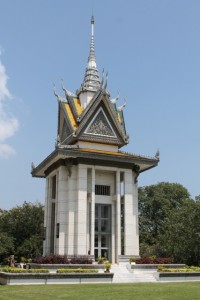After a harrowing six-hour drive from Siem Reap to Phnom Penh, John, Anne and I arrived into the heart of Cambodia’s capital city after nightfall and headed out to Cantina, a Mexican restaurant owned by a man from Santa Barbara (of all things!). John and I hadn’t had Mexican food since July, and I’m guessing for Anne it had been even longer, so the food and margaritas tasted great. We capped off the evening with a visit to Dairy Queen(!)–yes, they do have Dairy Queen in Cambodia!
The next morning things took on a much more somber tone when we drove out to visit the Killing Fields, an area outside of Phnom Penh where the Khmer Rouge took its prisoners to be tortured and executed, often being bludgeoned to death to save on bullets, and sometimes even being buried alive. Our audio guides allowed each of us to take in the experience on our own, as we listened to the disturbing history of the place and stories from some of the Khmer Rouge survivors. Between 1975-1979, the Khmer Rouge terrorized and devastated Cambodia, killing up to two million people and relocating all urban dwellers to forced labor camps in the rice paddies. Anyone wearing glasses, speaking a foreign language, or working in a profession like medicine or law was put to death. Supposedly, the Khmer Rouge envisioned an agricultural “paradise” where the people would live uncomplicated lives, just surviving from the land. In reality, people were sick and starving to death from being forced to work in the fields all day long with practically nothing to eat.
At the Killing Fields, where the bodies of 17,000 men, women, and children that were
executed during the genocide were later found buried in mass graves (there are hundreds  more sites like it around the country), a large glass stupa has been built in memorial to those killed. The stupa houses more than 8,000 skulls from the Killing Fields. It was an eerie visit, and incomprehensible, especially to think that many members of the Khmer Rouge continue to serve in the government today.
more sites like it around the country), a large glass stupa has been built in memorial to those killed. The stupa houses more than 8,000 skulls from the Killing Fields. It was an eerie visit, and incomprehensible, especially to think that many members of the Khmer Rouge continue to serve in the government today.
From the Killing Fields, we headed back to the city to visit the Tuol Sleng Genocide Museum. We hired a guide to take us around the museum, not realizing at first that she was a survivor of the genocide. The museum is housed in a former high school that was later used by the Khmer Rouge as a prison and torture center. After being tortured for information on dissidents, the prisoners were generally taken to the Killing Fields to be executed. Our guide was a remarkable woman and shared her personal story with us as she showed us around. Her father had been a member of parliament and her mother a French teacher, and since they belonged to the educated class, both were executed by the Khmer Rouge. During the genocide, our guide was separated from her siblings and sent to a work camp. Miraculously, her brother and sister also survived the genocide, with her sister having been selected to nanny for a Khmer Rouge family, which saved her from being killed. Our guide got teary-eyed as she told us about her family, as did we. After the Vietnamese invaded Cambodia in 1979, took over the government, and threw out the Khmer Rouge, our guide made her way back to Phnom Penh to return to her family’s home, but the government said it belonged to the state now, and sent her away. She managed to find her sister and brother over the next few years, and now she works in the museum as a way of processing the horror. She was so kind, and although it was incredibly sad, we really appreciated her sharing her story so openly with us.
In many ways, it seems that Cambodia has worked hard to overcome its past. Phnom Penh is bustling, and it’s hard to imagine that just 35 years ago, at the height of the Khmer Rouge, its population dwindled to about 1,000, as city dwellers were forcibly relocated to rural work camps, and all educated people were killed. Still, 75% of the country continues to survive from farming, and students attend school just for morning or afternoon shifts, as there aren’t enough classrooms and teachers for kids to attend school all day long. Health care is poor, and many people lack access to clean water, and trafficking and prostitution, which I’ll write more about in the next post, remain huge problems. Despite all of that, all of the people we met there were so kind, and we look forward to following along with Cambodia’s growth over the coming years.